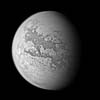| . |  |
. |
During a close flyby of Titan on March 31, 2005, Cassini's cameras got their best view to date of the region east of the bright Xanadu Region. This mosaic consists of several frames taken by the narrow-angle camera (smaller frames) put together with an image taken by the wide-angle camera filling in the background. It reveals new detail of dark expanses and the surrounding brighter terrain. Some of the features seen here are reminiscent of those seen elsewhere on Titan, but the images also reveal new features, which Cassini scientists are working to understand. In the center of the image (and figure A at bottom) lies a bright area completely surrounded by darker material. The northern boundary of the bright "island" is relatively sharp and has a jagged profile, resembling the now-familiar boundary on the western side of Xanadu (see PIA06159). The profile of the southern boundary is similar. However, streamers of bright material extend southeastward into the dark terrain. At the eastern end of the bright "island" lies a region with complex interconnected dark and bright regions (see figure B). To the south, the bright terrain is cut by fairly straight dark lines. Their linearity and apparently angular intersections suggest a tectonic influence, similar to features in seen in the bright terrain west of Xanadu (see PIA06158). The camera's near-infrared observations cover ground that was also seen by Cassini's synthetic aperture radar in October 2004 and February 2005. Toward the northeastern edge of the dark material a dark, circular spot in the middle of a bright feature (see figure C) is an approximately 80-kilometer-wide (50-mile) crater identified in the February 2005 radar data (see PIA07368 for the radar image). The resolution of this new image is lower but sufficient to reveal important similarities and differences between the two observations. Part of the crater floor is quite dark compared to the surrounding material at near-infrared wavelengths. This observation is consistent with the hypothesis that the dark material consists of complex hydrocarbons that have precipitated from the atmosphere and collected in areas of low elevation. At radar wavelengths the crater floor is much more uniform and there also are brightness differences seen by these two instruments outside of the crater. Such comparisons give Cassini scientists important clues about the roughness and composition of the surface material on Titan. Another interesting comparison is the "dark terrain" with small bright features as seen by the radar (see PIA07367) and the essentially inverted pattern (bright with small dark features) seen by the imaging science subsystem cameras. In the mosaic, this area is in the top left narrow-angle camera image. Within the bright terrain at the top of the mosaic, just left of center, lies a very intriguing feature: a strikingly dark spot from which diffuse dark material appears to extend to the northeast. The origin of this feature is not yet known, but it, too, lies within the radar image; Cassini scientists will thus be able to study it using these complementary observations. The mosaic is centered on a region at 1 degree north latitude, 21 degree west longitude on Titan. The Cassini spacecraft narrow-angle camera images were taken using a filter sensitive to wavelengths of polarized infrared light and were acquired at distances ranging from approximately 148,300 to 112,800 kilometers (92,100 to 70,100 miles) from Titan. Resolution in the images is about 1 to 2 kilometers (0.6 to 1.2 miles) per pixel. Related Links Cassini-Huygens at JPL Cassini Imaging Team SpaceDaily Search SpaceDaily Subscribe To SpaceDaily Express  Pasadena CA (JPL) Apr 06, 2005
Pasadena CA (JPL) Apr 06, 2005Although the Huygens probe has now pierced the murky skies of Titan and landed on its surface, much of the moon remains for the Cassini spacecraft to explore. Titan continues to present exciting puzzles.
|
| ||||||||||
| The content herein, unless otherwise known to be public domain, are Copyright 1995-2016 - Space Media Network. All websites are published in Australia and are solely subject to Australian law and governed by Fair Use principals for news reporting and research purposes. AFP, UPI and IANS news wire stories are copyright Agence France-Presse, United Press International and Indo-Asia News Service. ESA news reports are copyright European Space Agency. All NASA sourced material is public domain. Additional copyrights may apply in whole or part to other bona fide parties. Advertising does not imply endorsement, agreement or approval of any opinions, statements or information provided by Space Media Network on any Web page published or hosted by Space Media Network. Privacy Statement All images and articles appearing on Space Media Network have been edited or digitally altered in some way. Any requests to remove copyright material will be acted upon in a timely and appropriate manner. Any attempt to extort money from Space Media Network will be ignored and reported to Australian Law Enforcement Agencies as a potential case of financial fraud involving the use of a telephonic carriage device or postal service. |